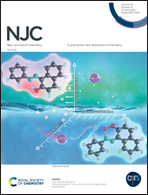Intermolecular hydrogen bonding-assisted aggregation induced emission in quinolone–quinazoline conjugates and their potential use in acidochromism†
Abstract
The effects of intermolecular hydrogen bonding on the aggregation behaviour for quinolone–quinazoline based D–A systems (Q1–Q3) have been reported. These compounds (Q1–Q3) have been strategically designed, synthesized and carefully characterized by spectral studies (IR, 1H, 13C-NMR, HRMS, UV/Vis, fluorescence) and their structures explicitly determined by X-ray single crystal analyses. Inclusion of apt electron donating groups (–H, Q1; –CH3, Q2 and –OCH3, Q3) enables these to display solvent-dependent emission indicative of a polarized excited state, probably due to enhanced intramolecular charge transfer (ICT). The occurrence of aggregation-induced emission enhancement (AIEE) in Q1–Q3 has been attributed to the restriction of the intramolecular rotation (RIR) and vibrations (RIV) via intermolecular hydrogen bonding. A possible role of the solvent and substituent in the photophysical behaviour and morphology of Q1–Q3 has been investigated by UV/Vis, emission, scanning electron microscopy (SEM) and dynamic light scattering (DLS) measurements. In addition, lowering of the energy gap between the HOMO and LUMO by electron donating substituents –CH3 (Q2) and –OCH3 (Q3) has been supported by DFT studies. Furthermore, they display reversible acid/base induced “ON–OFF–ON”-type signalling. The acidochromic behaviour upon exposure to acid/base has been supported by various studies.



 Please wait while we load your content...
Please wait while we load your content...